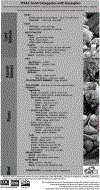An Updated Scheme for Categorizing Foods Implicated in Foodborne Disease Outbreaks: A Tri-Agency Collaboration
- PMID: 28926300
- PMCID: PMC6317073
- DOI: 10.1089/fpd.2017.2324
An Updated Scheme for Categorizing Foods Implicated in Foodborne Disease Outbreaks: A Tri-Agency Collaboration
Abstract
Background: Foodborne disease data collected during outbreak investigations are used to estimate the percentage of foodborne illnesses attributable to specific food categories. Current food categories do not reflect whether or how the food has been processed and exclude many multiple-ingredient foods.
Materials and methods: Representatives from three federal agencies worked collaboratively in the Interagency Food Safety Analytics Collaboration (IFSAC) to develop a hierarchical scheme for categorizing foods implicated in outbreaks, which accounts for the type of processing and provides more specific food categories for regulatory purposes. IFSAC also developed standard assumptions for assigning foods to specific food categories, including some multiple-ingredient foods. The number and percentage of outbreaks assignable to each level of the hierarchy were summarized.
Results: The IFSAC scheme is a five-level hierarchy for categorizing implicated foods with increasingly specific subcategories at each level, resulting in a total of 234 food categories. Subcategories allow distinguishing features of implicated foods to be reported, such as pasteurized versus unpasteurized fluid milk, shell eggs versus liquid egg products, ready-to-eat versus raw meats, and five different varieties of fruit categories. Twenty-four aggregate food categories contained a sufficient number of outbreaks for source attribution analyses. Among 9791 outbreaks reported from 1998 to 2014 with an identified food vehicle, 4607 (47%) were assignable to food categories using this scheme. Among these, 4218 (92%) were assigned to one of the 24 aggregate food categories, and 840 (18%) were assigned to the most specific category possible.
Conclusions: Updates to the food categorization scheme and new methods for assigning implicated foods to specific food categories can help increase the number of outbreaks attributed to a single food category. The increased specificity of food categories in this scheme may help improve source attribution analyses, eventually leading to improved foodborne illness source attribution estimates and enhanced food safety and regulatory efforts.
Keywords: IFSAC; food categorization; foodborne; outbreak.
Conflict of interest statement
Disclosure Statement
No competing financial interests exist.
Figures





Similar articles
-
Investigations of Possible Multistate Outbreaks of Salmonella, Shiga Toxin-Producing Escherichia coli, and Listeria monocytogenes Infections - United States, 2016.MMWR Surveill Summ. 2020 Nov 13;69(6):1-14. doi: 10.15585/mmwr.ss6906a1. MMWR Surveill Summ. 2020. PMID: 33180756 Free PMC article.
-
Recipes for foodborne outbreaks: a scheme for categorizing and grouping implicated foods.Foodborne Pathog Dis. 2009 Dec;6(10):1259-64. doi: 10.1089/fpd.2009.0350. Foodborne Pathog Dis. 2009. PMID: 19968563
-
Surveillance for foodborne disease outbreaks - United States, 1998-2008.MMWR Surveill Summ. 2013 Jun 28;62(2):1-34. MMWR Surveill Summ. 2013. PMID: 23804024
-
Outbreaks where food workers have been implicated in the spread of foodborne disease. Part 3. Factors contributing to outbreaks and description of outbreak categories.J Food Prot. 2007 Sep;70(9):2199-217. doi: 10.4315/0362-028x-70.9.2199. J Food Prot. 2007. PMID: 17900100 Review.
-
Prevalence of foodborne pathogens in food from selected African countries - A meta-analysis.Int J Food Microbiol. 2017 May 16;249:35-43. doi: 10.1016/j.ijfoodmicro.2017.03.002. Epub 2017 Mar 6. Int J Food Microbiol. 2017. PMID: 28271855 Review.
Cited by
-
Associating sporadic, foodborne illness caused by Shiga toxin-producing Escherichia coli with specific foods: a systematic review and meta-analysis of case-control studies.Epidemiol Infect. 2019 Jan;147:e235. doi: 10.1017/S0950268819001183. Epidemiol Infect. 2019. PMID: 31364553 Free PMC article.
-
Novel Outbreak-Associated Food Vehicles, United States.Emerg Infect Dis. 2021 Oct;27(10):2554-2559. doi: 10.3201/eid2710.204080. Emerg Infect Dis. 2021. PMID: 34545783 Free PMC article. Review.
-
Environmental inactivation and irrigation-mediated regrowth of Escherichia coli O157:H7 on romaine lettuce when inoculated in a fecal slurry matrix.PeerJ. 2019 Mar 8;7:e6591. doi: 10.7717/peerj.6591. eCollection 2019. PeerJ. 2019. PMID: 30867998 Free PMC article.
-
GenomeGraphR: A user-friendly open-source web application for foodborne pathogen whole genome sequencing data integration, analysis, and visualization.PLoS One. 2019 Feb 28;14(2):e0213039. doi: 10.1371/journal.pone.0213039. eCollection 2019. PLoS One. 2019. PMID: 30818354 Free PMC article.
-
Distribution of Antimicrobial Resistance Genes Across Salmonella enterica Isolates from Animal and Nonanimal Foods.J Food Prot. 2020 Feb 1;83(2):295-304. doi: 10.4315/0362-028X.JFP-19-310. J Food Prot. 2020. PMID: 31961231 Free PMC article.
References
-
- Batz MB, Hoffmann S, Morris JG Jr. Ranking the disease burden of 14 pathogens in food sources in the United States using attribution data from outbreak investigations and expert elicitation. J Food Prot 2012;75:1278–1291. - PubMed
-
- Braden CR, Tauxe RV. Emerging trends in foodborne diseases.Infect Dis Clin North Am 2013;27:517–533. - PubMed
-
- Centers for Disease Control and Prevention (CDC). Surveil-lance for Foodborne Disease Outbreaks, United States, 2014, Annual Report. Atlanta, GA: U.S. Department of Health and Human Services, CDC, 2016.
-
- Centers for Disease Control and Prevention (CDC). Surveil-lance for Foodborne Disease Outbreaks, United States, 2015, Annual Report. Atlanta, Georgia: US Department of Health and Human Services, CDC, 2017.
-
- DeWaal CS, Glassman M. Outbreak Alert! 2001–2010: A Review of Foodborne Illness in America. Washington, DC: Center for Science in the Public Interest, 2013.
MeSH terms
Grants and funding
LinkOut - more resources
Full Text Sources
Other Literature Sources
Medical

